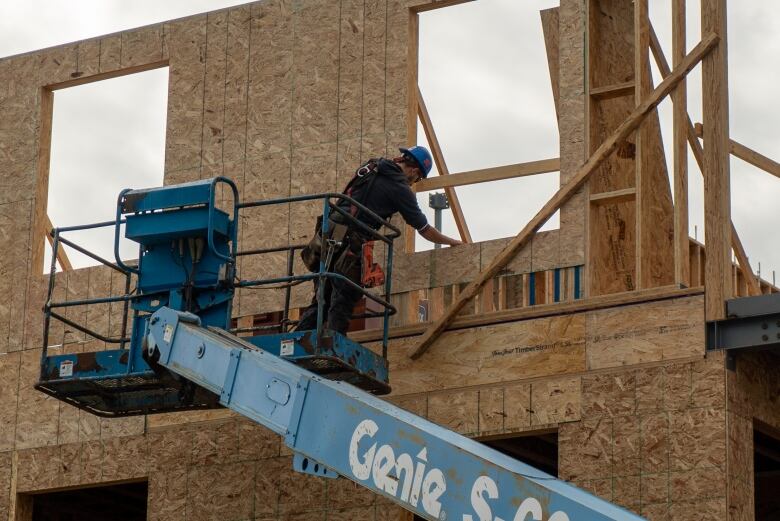Can we build them? Yes we can, city officials say of Thunder Bay, Ont.'s housing goals
Northwestern Ontario city looks to incentivize developers, add density to core areas to meet housing needs

It's an ambitious target: 2,100 new homes in Thunder Bay, Ont., in the next three years.
So, how can that goal be reached?
City officials say they're confident it can be done, pending a chunk of change from the federal government's Housing Accelerator Fund. Thunder Bayis one of nine municipalities in the province that have met their targets for new housing starts this year, surpassing its goal with177 units under construction.
The other municipalities that met or exceeded their 2023 goalsare:
- Chatham-Kent.
- Innisfil.
- Kingston.
- Pickering.
- Sarnia.
- Toronto.
- Welland.
- Whitchurch-Stouffville.
In the case of Thunder Bay, director of development servicesJoel DePeutersaid, "The early indications are that there is a sufficient amount of infill property that's available to meet the target.
"Work has been underway for quite some time to ensure that there is an adequate supply of available land and service land."
City staff are currently finishing a review of city-owned propertiesavailable for surplus and sale that could be redeveloped for housing or commercial purposes. Staff have already identified 40 city-owned properties that together could support about 1,000 housing units.
A report with more details about these properties is expected to come to council in closed session next month.
Beyond that, DePeuter said,there is room for thousands more units on vacant lands within already-serviced areas. There'salso capacity for 2,000 units on lands already within various stages of subdivision approval, he said.
Until then, as the city waits for news from Ottawa, planning is underway so when there's money, developers will come.
Drawing in developers
The city itself isn't responsible for building houses. Its main task is figuring out how to attract developers, with funding coming from a large portion of the $45.6 million requested from the federal government.
"A large amount of that money would be used to incentivize development on existing services to create more density and to encourage affordable units," said DePeuter. "It would also be used for studies that would help to streamline development."

According to DePeuter, 290 new building permits have been issued this year, nearly double the five-year rate. Both he and Coun. Kristen Oliver attribute that success to recent changes to the city's official plan and zoning bylaw.
"Even during challenging times with supply chain hiccups and access to materials, we saw significant growth in terms of our housing in this community this past year," Oliver said.
"Having some conversations with developers, they're really finding this as an accessible tool to reduce some of the burden and red tape."
'Once in a generation growth'
Thunder Bay's three-year plan is to build 2,113 units, but it'salso committed to a target set by the province: 2,200 new homes by 2031. Since the city has made that pledge, it will have easier access to Ontario's$1.2-billion Building Faster Fund.Additionally, it allows Mayor Ken Boshcoff to seek strong mayor powers. The mayor has already devised plans for a housing accelerator task force to keep the city on track.
DePeuter saidthe city's preference, andthe most cost-effective strategy for taxpayers, is to mostly build on existing infrastructure.
"There is very little additional cost to the city that results from building on existing services. The city has already placed pipes in the ground,and constructed roads and maintained those roads."

Oliver saidthe city is encouraging creative housing solutions, such as multi-dwelling units and accessory dwellings, that add density to core areas, especially as its aging population looks to downsize.
"The opportunity that we have in front of us is really a once in a generation growth that we're going to be seeing in this community."
Training more tradespeople
Ontario needs more than 100,000 additional workers to join the construction industry in the next decade, according to the province. Labour Minister David Piccini says northern Ontario currently has about 17,000 vacant jobs, many of them in the trades.
That begs the question: who is going to build Thunder Bay's new homes?
Confederation College offers a one-year carpentry and renovation techniques program, and a more thoroughcarpentry apprenticeship program,which offers education to apprentices signed up through the provincial government.
The apprenticeship program has 20 spaces per class. The governmentcommunicates closely with the college about what levelsof skilled workers are most needed in the province, and the college responds accordingly.

"The government basically gives us a list of people and then we provide the spaces for that," said Lyndon Wagenaar, a full-time faculty member for the college's carpentry apprenticeship program.
"After each level, they go back to their employer and put in more hours. They need to get about 7,000 hours total working time before they can write their final trade exam or their Red Seal ticket." (A Red Seal on a provincial or territorial trade certificate indicates holders havethe knowledge and skills needed to practise their trade across Canada.)
After that, Wagenaar said there areendless opportunities for work locally, from residential developments to big projects like the new Thunder Bay Correctional Complex.
Wagenaar admittedthe city's housing targets are aggressive.
"Potentially it can happen, but we have to start training more and getting more people through the programs."
One big draw to the trades is most of the schooling is paid for by the government, he said.
"You get to go through unemployment, you get paid while you're coming to school, and then there's bonuses for when you finish each level for either tools or spending money," Wagenaar said.
Justin Reid is wrapping up his first year as a carpenter apprentice. He took the college's mechanical techniques program a decade ago to get a feel for the industry, and is now working at RML Contracting Ltd. while finishing his education.
He is constantly hearing about the need for more tradespeople in town.
"It's crazy how much talk there is about needing more people, not even just tradespeople,but labourers to help with everything," Reid said. "Every person counts and sometimes it's hard to come by people."
Reidprefers adding the finishing touches to projects rather than building houses from the ground up, but said,"I would encourage people right out of high school to takeintroductory courses and see what they like."












_(720p).jpg)


 OFFICIAL HD MUSIC VIDEO.jpg)
.jpg)



























































































